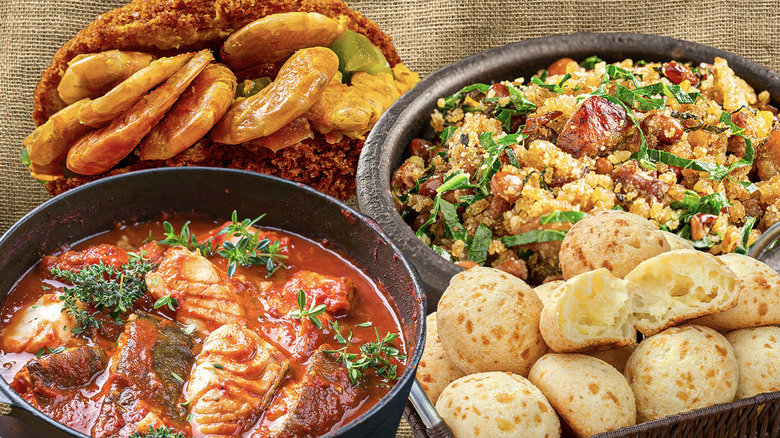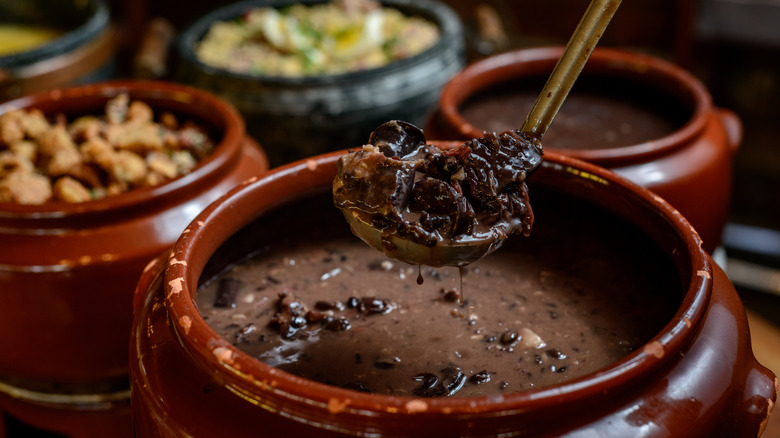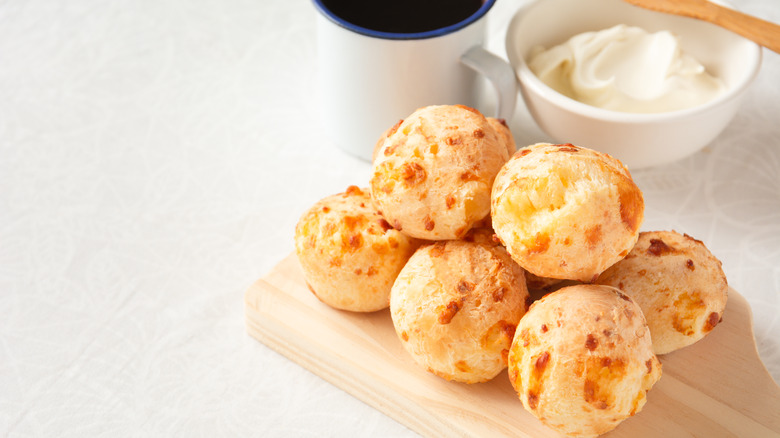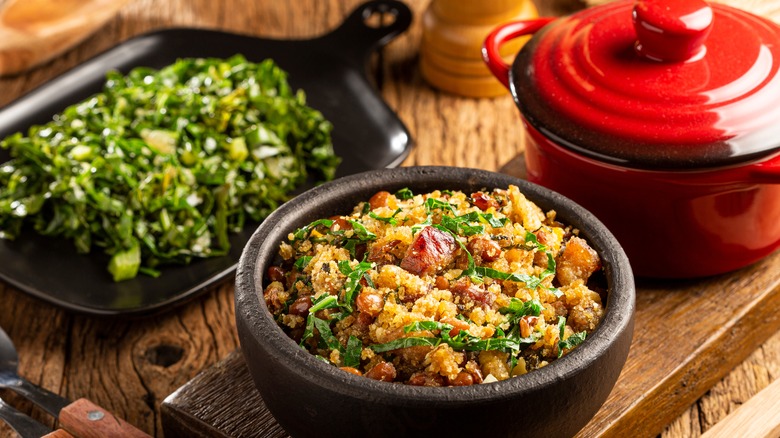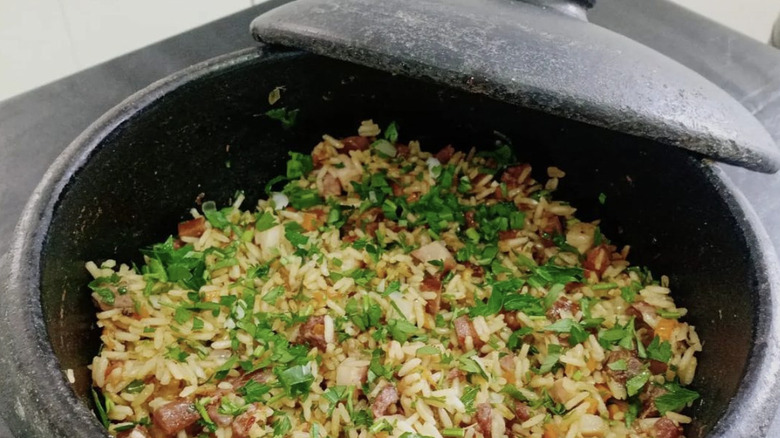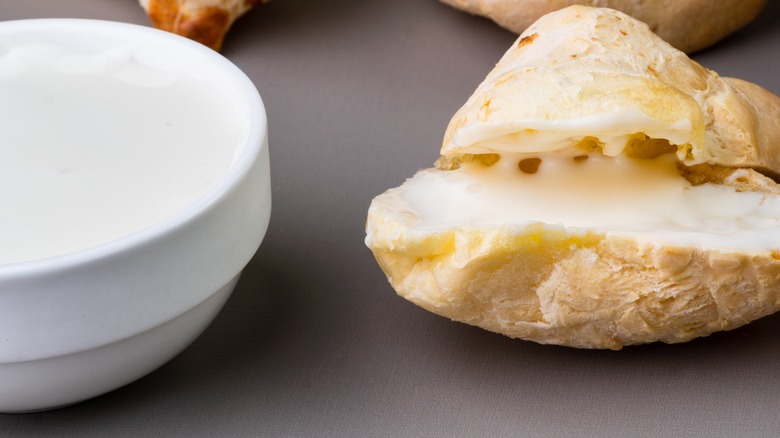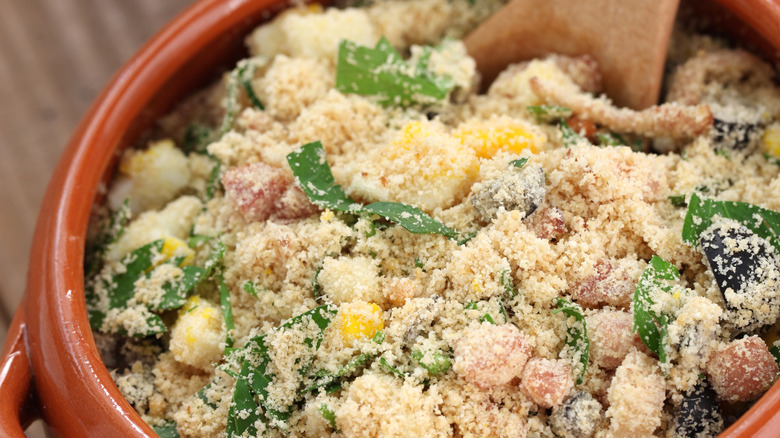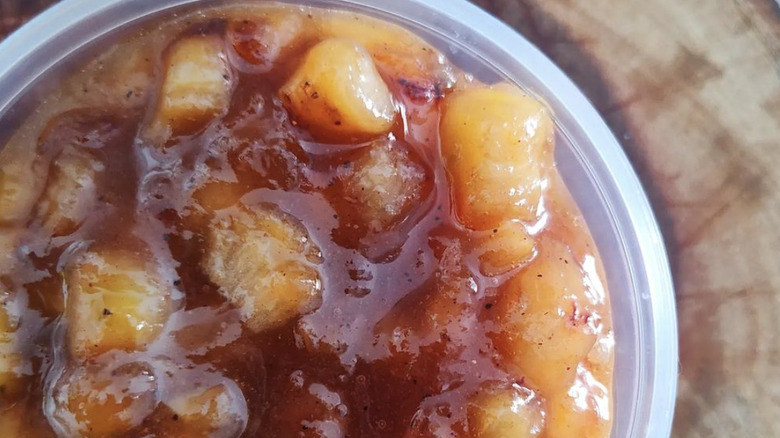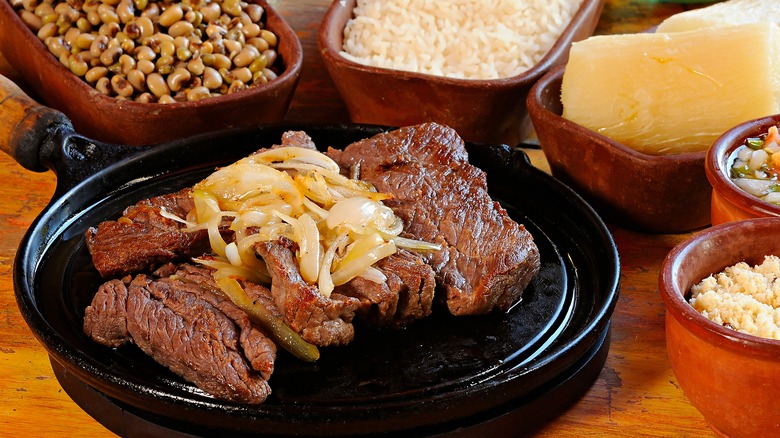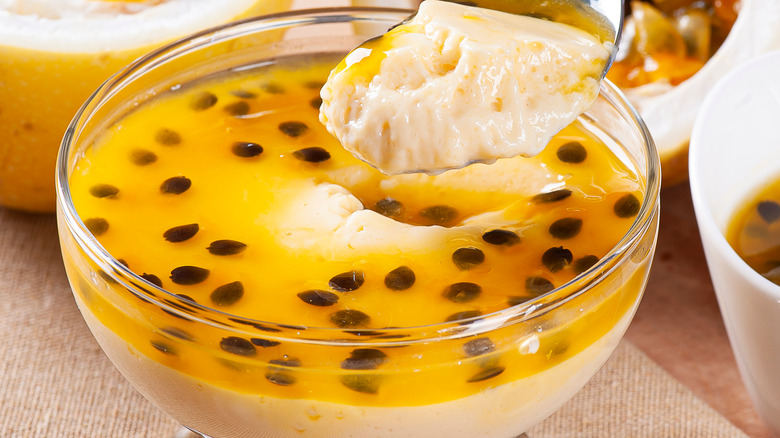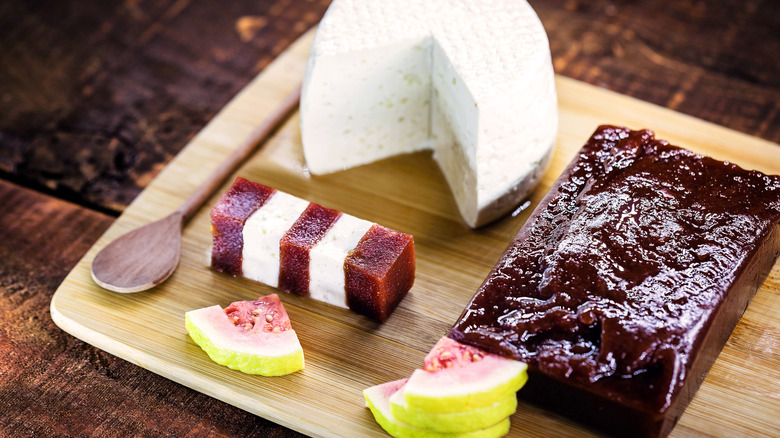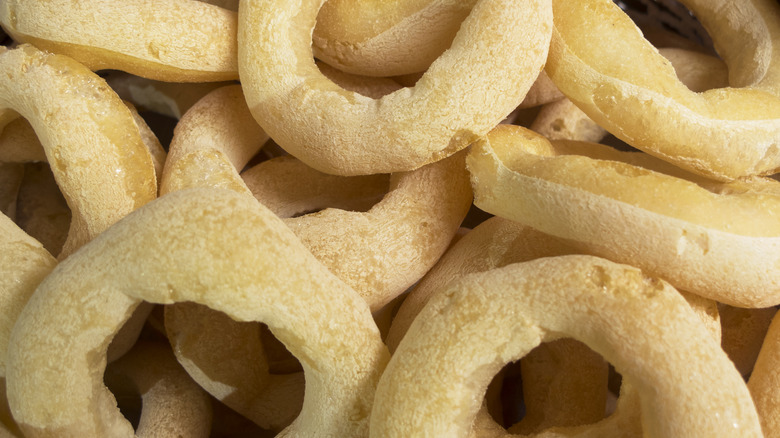15 Brazilian Foods That You Must Try, Other Than Barbecue
It's no secret that Brazilian barbecue (churrasco) has been steadily gaining popularity since it was first introduced to the United States in 1995. After all, the idea is something that many people from different cultures love: simply grab a chair, watch as spears of meat circulate through the restaurant, and eat as much of whichever cut of meat tickles your fancy.
While there are many Brazilian steakhouses (churrascarias) that are considered "mom and pop" restaurants, larger chains have played a major role in spreading the concept all over the world. Not least among them is the famous all-you-can-eat steak chain, Fogo de Chão, which has no plans to stop expanding. Projections discussed in Restaurant Dive suggest that the business is expected to grow in the coming years. Some estimates even project that the company will increase in size by 15% per annum.
As the churrascaria craze has spread internationally, however, many other elements of Brazilian cuisine have been left behind. Considering that Brazilian food draws on traditions from indigenous nations, West African cultures, Portugal, France, and Japan, among other regions, it offers some of the most diverse eats in the entire world. From the Afro-Brazilian invention of feijoada to the indigenous dish of maniçoba, these are the Brazilian foods that you must try.
1. Feijoada
Feijoada is, in many ways, a symbol of Brazilian culture. This black bean stew with bits of assorted pork parts has been eaten in the region for centuries and continues to appear on menus across the country. Although it is difficult to say exactly when or how feijoada was discovered, it is believed that this meal was invented by enslaved chefs sometime before emancipation in 1888.
Legend has it that these people were only given rice, beans, and undesirable scraps of meat to serve other enslaved Afro-Brazilians at mealtimes. Thus, in a move of creativity and resilience, these cooks dreamed up feijoada, which soaks up the flavor of the pigs' ears, feet, and more to give the black bean base a hint of fattiness. On a trip to São Paulo, celebrity chef Anthony Bourdain applauded this dish for the way it reflects the resilience of the Brazilian people, taking some of the worst cuts of meat and transforming them into a delicacy.
Beyond the Afro cultural influence on feijaoda, it is important to note that indigenous people had been consuming beans in modern-day Brazil for centuries before colonization. Thus, it is hardly surprising that a bean-based stew eventually became the unofficial national dish of Brazil.
2. Moqueca
Feijoada is not the only Brazilian dish that has its roots in both Afro-Brazilian and indigenous culinary traditions. Moqueca, a savory type of baked seafood stew, also has its roots in several different cultures. This dish itself involves cooking some combination of fish, prawns, mussels, and assorted shellfish in a mixture of spices. While every moqueca cook has their own special recipe, common ingredients include cilantro, coconut milk, and palm oil. The result is a dish that is rich, fatty, and satisfying.
It is believed that moqueca comes from pokeka, a culinary style invented by the native Tupi people of Brazil. Meaning "rolled" in the Guaraní language, pokeka involved wrapping a fish in palm leaves and then baking it in a traditional regional type of oven, called the moquém. Thus, it is believed that moqueca — baked fish and seafood stew — comes from the idea of preparing pokeka in a moquém.
Of course, when Africans arrived in Brazil, they added their own cultures, traditions, and tastes to the local culinary scene. Afro-Brazilians are credited with adding coconut milk and palm oil to the moqueca recipe, giving it a more decadent taste.
3. Pão de queijo
Pão de queijo ("cheese bread") is a bite-sized treat that many Brazilians enjoy for breakfast. Hailing from the region of Minas Gerais, this dish is considered one of the most classic national favorites. To prepare it, cooks mix tapioca with cheese and then shape the resulting batter into balls. These spheres are then baked in the oven until they become crisp and chewy on the outside and light and fluffy on the inside.
While the most common type of cheese to use in pão de queijo is parmesan, cooks can add whichever cheese suits their fancy. For a more flavorful version of this dish, it's best to use a sharper cheese, like cheddar or manchego. However, people who enjoy milder flavors can use a creamier option, such as mozzarella.
Just because pão de queijo already has cheese baked inside of its dough, though, doesn't mean that you can't smother even more cheese onto the final product. At breakfast time, many Brazilians like to break their spheres into two pieces and lather the interior with a buttery cheese spread called reiqueijão. Pair this combination with some fruit and a strong cup of Joe, and you will have the most typical Brazilian morning treat.
4. Feijão tropeiro
Although Brazil is world-famous for its beaches (hello Copacabana!), many of the country's interior regions are known for raising cattle, donkeys, and horses. This has been true since the 17th century when the "tropeiros" — or animals transporters — began escorting these beasts along the long highways in the green hilly regions of Minas Gerais, Goiás, and the state of São Paulo.
As these tropeiros guided animals from place to place, they couldn't always find a place to stop and eat. As a result, they had to pack their own meals with them, and for their food to be effective, it could not spoil. Thus, feijão tropeiro ("tropeiro rice") was invented. This dish combines black beans, beef jerky, salted bacon, cassava flour, and salt to create a hearty, filling meal that doesn't go bad easily. It grew so popular with tropeiros that, eventually, other kinds of workers started to enjoy it, as well.
Of course, the old tropeiro culture has mostly died. Starting in the 20th century, these workers were largely replaced by truck drivers. Even so, people in Brazil continue to enjoy tropeiro rice for its easy transportability and unique flavors.
5. Arroz carreteiro
Feijão tropeiro is not the only type of Brazilian dish that was born of the need for transportability. Arroz carreteiro ("wagoner rice") was also invented for this same purpose. Back in the day, southern Brazil was full of carreteiros, workers who would transport goods across the country by driving donkey-pulled wagons. As they traveled, they needed to bring food along with them, preferably something that could keep well over large stretches of time.
In the region of Minas Gerais, arroz carreteiro was the solution to that problem. Wagoners could carry the simple ingredients of rice, preserved dried beef, and onions with them on their journeys. Then, when they were ready to settle in somewhere for an evening, they would prepare a fire, heat up an iron-cast pan, and use it to cook all of the ingredients together.
The result was a sizzling hot rice dish that carried a strong, meaty flavor. Although the culture of wagoners has slowed down in the past century, many people still enjoy this dish. Modern alterations include adding carrots, cabbage, and garlic.
6. Catupiry
Invented in Brazil more than a century ago, catupiry has become an integral ingredient in local cuisine. And how could it not be? This delightful cheese spread is reminiscent of the artisan cream cheeses made at New York City institutions. After all, similar to cream cheese, catupiry is made primarily with whole milk or cream. That being said, unlike its American cousin, this cheese spread goes through a less intense fermentation process, leaving it with a more buttery and less acidic flavor.
Interestingly, catupiry is so popular in Brazil that cooks integrate this ingredient into all kinds of different recipes. It is slathered on pizza with juicy slices of turkey, piled on top of fruit preserves, and even stuffed inside sushi rolls. As a 2018 CNN Brasil report declared, "It is difficult to meet a Brazilian who doesn't know the brand, Catupiry." In the end, this evaluation makes sense — it is literally everywhere.
7. Farofa
It's hardly news that rice and beans are a major part of Brazilian cuisine, but not everybody knows about farofa. Made of cassava flour, this nutty and granular substance makes for the perfect garnish for the classic rice and beans combo. Simply load up your plate with rice, pour some black beans on top, then sprinkle a spoonful of farofa over it all. This grain will add a satisfying texture to your dinner, giving your palate a more interesting experience.
Although farofa is most famously served with rice and beans, you can find it on everything from Brazilian barbecue to feijoada to cabbage. Part of the reason that this dish is so universal in Brazil could pertain to its long history in the region. Indeed, farofa was first invented by indigenous Brazilians, who used to cook cassava flour in tortoise fat to create a meal that was both dense and nutty in flavor. These days, cooks continue to cook farofa in fat, albeit with bacon.
8. Doce de banana
Because Brazil is considered the world's third-largest fruit producer, the country's grocery stores are teeming with juicy, succulent options (via Scielo). This is especially true when it comes to bananas, as Brazil actively cultivates at least half a dozen different banana varieties. Of course, having this degree of choice at the market means that local chefs can select their produce carefully based on what they want to make. Thus, the country's sugariest bananas are often used to make a dessert called "doce de banana" ("banana sweets").
To make doce de banana, cooks will select either the banana d'agua or the banana prata, although folks looking for a less sugary option might reach for the latter. Then, they cook these fruits down in a pan with a bit of sugar so that they caramelize. Most cooks will add cloves to the mix, as this spice can give the dessert a pungent kick that helps balance out the dish's richer, sugary overtones. For the best results, serve this treat with a slice of fresh cheese, preferably queijo minas.
9. Acarajé
Acarajé is one of the Brazilian dishes with the richest cultural history. Originally from West Africa, this fried treat came to the northeastern region of Brazil during the era of the slave trade. Despite all odds, the recipe for acarjé was preserved by enslaved cooks for hundreds of years, who used this recipe to keep a piece of their heritage with them. These days, acarjé remains culturally significant to the Afro-Brazilian community, where the dish has become a symbol of resistance.
To make acarajé, cooks start out by making a paste out of beans, onions, and ginger. They then shape this batter into balls before frying them in palm oil. Ultimately, these savory dough balls are split down the middle and stuffed with ingredients like shrimp, sun-dried beef, or hot peppers. The result is a dish that is crunchy on the outside and bursting with flavor on the inside. To add an extra level of complexity, smother your acarajé with vatapá, a savory paste made of shrimp, palm oil, and ground nuts.
10. Pato no tucupí
Pato no tucupí ("duck in tucupí sauce") is a delightful dish from the region of Pará. Its roots can be traced back to indigenous times, when people were searching for a way to make a certain type of cassava edible. Known now as the cassava brava, this tuber is extremely poisonous, as it naturally contains cyanide.
To try to get nutritional value out of this ingredient, the indigenous people discovered that they could make it edible by extracting juice from the root, fermenting it, and cooking it. Known as tucupí, the resulting yellow sauce provides a refreshing acidic taste.
While there are many ways to enjoy tucupí, one of the most popular uses is in baked duck. To make pato no tucupí, cooks season and marinate the bird normally, before throwing it in the oven to bake. Once the dish is almost ready, though, they pull it from the oven and cook it in a pan full of juicy and tangy tucupí.
11. Maniçoba
Tucupí sauce is not the only Brazilian dish that seeks to salvage part of the ultra-poisonous cassava brava. The plate known as maniçoba uses a special culinary technique to clear the poison from the cassava's cyanide-laced leaves, transforming it into a rich and savory meal. Before the brutal years of Portuguese colonization, the indigenous people of Brazil developed this dish with a lot of patience. They ultimately discovered that cassava leaves became edible after boiling them for seven days. What's more, they found that the resulting meal had a light, savory flavor that combines well with rice and animal fat. Maniçoba was born.
These days, maniçoba is consumed throughout the Northeast of Brazil. Nicknamed "a beans dish that has no beans," maniçoba is often served over a bed of white rice. To make the meal more substantial, many cooks like to add bits of dried meat, bacon, or even sausage. The result is a meal that is earthy yet fatty.
12. Carne de sol
Carne de sol means "meat of the sun" in Portuguese, and there is a definitive reason for this. During the 17th century, before refrigeration was widely available, people in Brazil needed a way to preserve beef for long periods of time. In the northeast part of Brazil, this problem was resolved by salting the meat and leaving it out in the sun to dry. Although carne de sol is a truly Brazilian dish, the culture of cured meats was brought to the region by the Portuguese, who have a long tradition of serving dried hams and sausages.
These days, with the invention of the refrigerator, sun drying meat is no longer necessary as a tactic for preservation. Nevertheless, people across Brazil continue to enjoy carne de sol, as the curing process can make beef more flavorful. Foodies also enjoy the texture of carne de sol, which is extra succulent when cooked on low heat for long periods of time. For this reason, this ingredient is best prepared in a stew, like feijoada, or even baked into a casserole.
13. Mousse de maracujá
If you like chocolate mousse, you will likely love passionfruit mousse, as well. Known as mousse de maracujá in Portuguese, this dish combines the sour flavor of passionfruit with condensed milk to create a dessert that is both refreshing and sweet. It is worth noting, though, that moussse de maracujá is the type of dish that can vary considerably from household to household. Depending on who is cooking, this dish can be topped with passionfruit sauce, glazed with white chocolate, or even served beneath a layer of chocolate pudding.
Interestingly, passionfruit desserts are fairly common in Brazil. For one thing, as revealed by local outlet Agro20, the country is the world's largest producer of this flavorful fruit. For another, the quasi-sour acidity of the passionfruit does an excellent job of balancing out heavier, sweeter ingredients like sugar, chocolate, or condensed milk. Because of this, passionfruit cake, passionfruit ice cream, and even passionfruit puddings are found throughout Brazil. Mousse de maracujá, however, is a local favorite due to its light yet creamy consistency.
14. Romeu e Julieta
Mousse de maracujá is far from being the only popular Brazilian dessert. Romeu e Julieta is another local favorite, and yes, it was named after the Shakespeare play. Romeu e Julieta is the name attributed to what many people consider the perfect combination: a type of fresh cheese called queijo minas and a type of guava preserve called goiabada.
When served the most traditional way, Romeu e Julieta involves a slice of cheese and a portion of goiabada that are eaten straight up together on a plate. Here, the natural sugars of the goiabada mingle with the mild acidity of the cheese to create a combination that is both decadent and creamy. That being said, there are many different ways to enjoy Romeu e Julieta's unique flavors. Queijo minas and goiabada are often served in a type of fried dough called a pastel, and can even be used as a substitute for cake frosting. To indulge on the go, you can also eat these elements stacked over each other and skewered on a stick.
15. Mate com biscoito globo
Nothing says "Rio de Janeiro" quite like mate com biscoito globo. This combination of cold mate tea and light, crunchy cookies is considered a beachside favorite. Indeed, these ingredients are perfect for staying cool on a hot summer day. The slightly bitter flavor of the mate tea, which is often sweetened by combining it with freshly-squeezed fruit juice, proves refreshing under the sun. Meanwhile, light and airy globo cookies provide a satisfying snack without weighing heavily on your stomach.
Sadly, however, scandal rocked the city of Rio de Janeiro in 2016 when a New York Times reporter visited the biscoito globo factory and wrote that these treats are "a party to which your tongue was not invited." The journalist, however, missed the point. Unlike carne seca or moqueca, which are enjoyed for their explosive flavors, biscoito globo is hailed as a form of subsidence on one of those hot days where the sun robs your appetite. Grab a beach towel, soak up some rays, chat with your friends, and split a bag of biscoito globo (the salty flavor is, arguably, the best). If you wash it all down with a cold cup of sweetened passionfruit mate, there is no way you will be disappointed.
